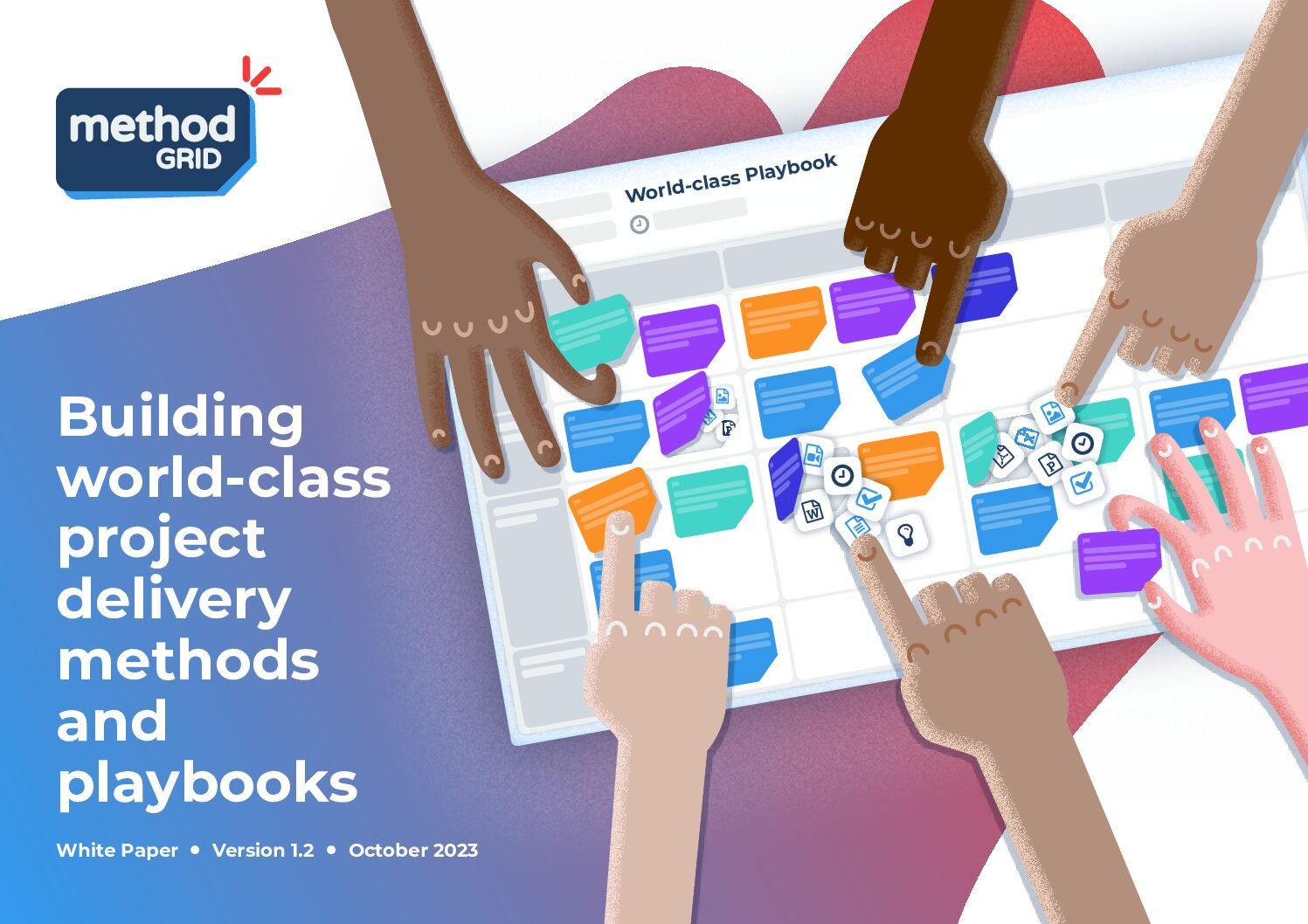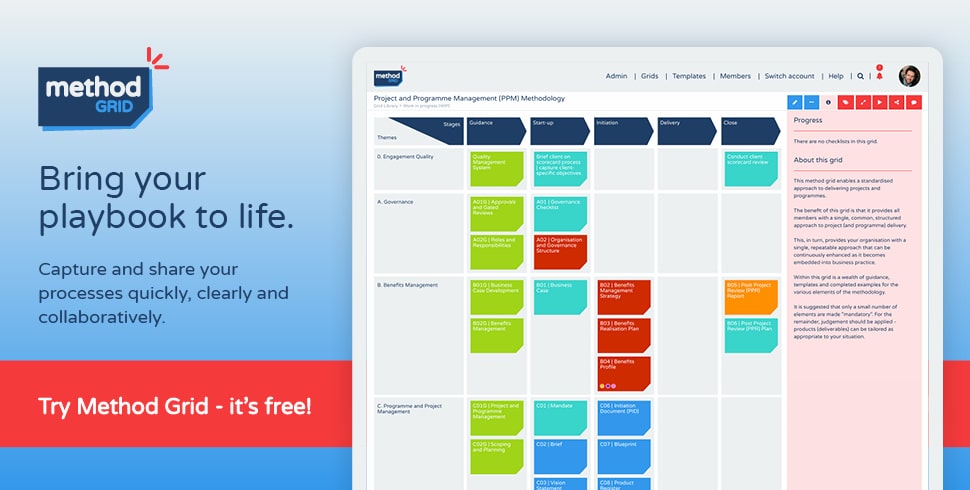A tough decision - MAVEN wins the day - A very wide gulf indeed - The DNA of your business - Three IP buckets - Being paid to build - What the hell is an EMP? - IDEAS will help you get there - Build your moat
In a previous blog, in a series on knowledge management (KM), I outlined a set of eight illustrative practical levers (i.e. ideas, practices, tools) that can bring your KM Strategy to life. This week’s blog unpacks lever 04: Systematic development of your intellectual property (IP).
Eight illustrative knowledge management levers:
Lever 01: Form a KM team
Lever 02: Run regular knowledge fairs
Lever 03: Develop a who-knows-what directory
Lever 04: Systematic development of your intellectual property (IP)
Lever 05: Develop and curate your knowledge repositories – tactical/strategic
Lever 06: Organizational learning and aligning your KM and HR strategies
Lever 07: Undertake regular KM audits
Lever 08: Regular staff communication
Lever 04: Systematic development of your intellectual property (IP)
As readers of this series will know, I lean heavily towards the personalization end of knowledge management (see this blog on KM strategy options for more).
That said, an inescapable truth is that the most successful – and valuable – professional service businesses invest intelligently and systematically in the ongoing build-out of their IP.
Before I expand on this – let’s go on a short thought experiment.
Let’s say you are the finance director for a large corporate, with budget, looking to acquire company X – a small-firm that your colleagues recently identified in a very detailed discovery exercise. Initial conversations with the owners of Company X have progressed well into an exclusive offer period and you now seek some detailed commercial due diligence on the target before confirming the deal.
But, your company has scant history in commissioning such due diligence – this is only the second acquisition they have ever made. You have, personally, only been through such an acquisition exercise once before – in your dim and distant past.
You need some expert professional support.
First step: a google search on the term “commercial due diligence services”. Next step: probably the development of a list of potential professional advisors who claim to have such expertise – and through some qualitative filter – the development of a short list for more detailed conversations. You need to get this choice right!
After receiving support proposals, you have scheduled a one-hour session with the leading three for final decision. You have probably drawn up a weighted evaluation framework to surreptitiously scribble your 1-10 scores on as you listen to the pitches.
What is likely to be on that scoring framework? Well, for sure, you will want to evaluate their understanding of your unique situation/requirement, the individual members of their team – certainly, their project lead, the firm’s general delivery experience and reputation and, of course, the price.
What is also likely to be on that list is the “how?”.
You will want to be 100% assuaged that, by dint of their expertise – and having been through this type of exercise many times before – they have a refined methodology, a deep toolbox of relevant resources, a prescribed way of working that means their delivery excellence is not predicated solely on the happenstance of advisor variability but, rather, based on hundreds of cycles of their hard-earned-and-learned corporate endeavour.
As a smart buyer, you will want to really interrogate this aspect.
Now let’s say that all qualities (and scores) were broadly equal until you asked the question: “How will you go about such an engagement – what is your methodology or process for this type of work?”.
One company representative looked at you blankly, one confidently rushed through a busy Powerpoint slide replete with chevrons (you suspect was just knocked up the night before the pitch) and another, a small boutique, said:
“Great question. We believe that exploring all of your potential supplier’s methodologies is a great way to get beyond the sound-bite of claimed expertise. We are deep specialists in this area; Commercial Due Diligence is all we do and we pride ourselves on the method and toolbox we have built out over the years – we call it MAVEN – to guide us through every engagement. I would love to talk you through it.”
They go on to open MAVEN up for you on screen.
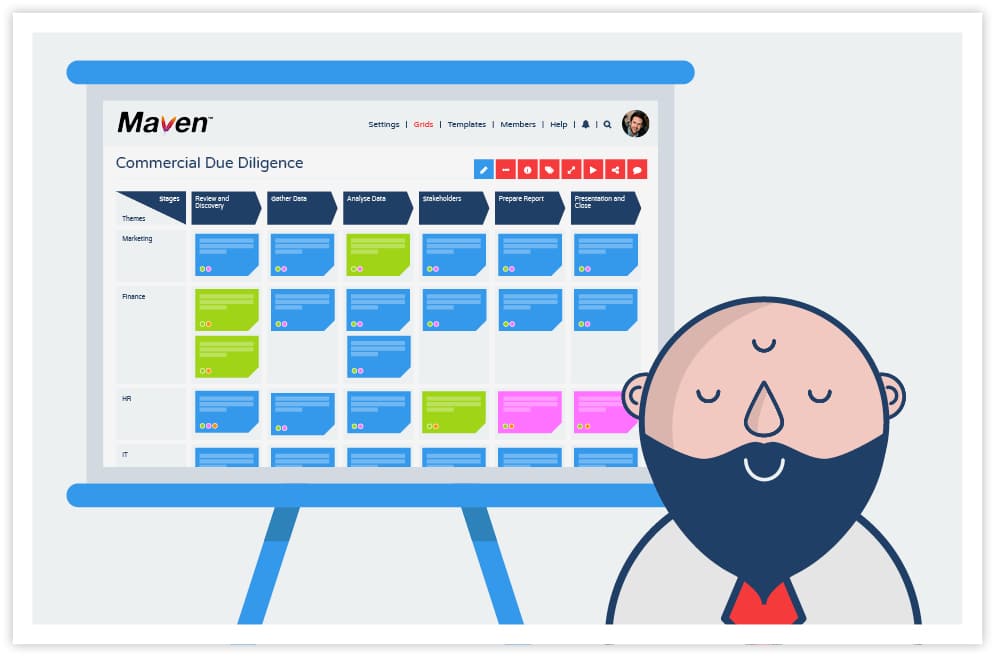
It is evidently logically structured, and filled with rich evidence of expertise – guidance for their team, tools and templates, examples of best-practice deliverables and links to other experts in their wider firm (clearly a supportive, collegial culture).
You don’t have time to go through it all in detail but it is evidently something that has been built collaboratively over a considerable period of time. The high-level sense of rigour and depth has you scribbling a “9” in the Delivery Methodology box. MAVEN has blown the other two out of the water. A demonstrable reinforcement of their claimed expertise – your confidence in them now is palpably high. Time to get them in.
That is a very real world scenario.
I know.
I have sat many times – that side of the table – helping clients make such commercial calls and seen the very, very wide gulf between espoused-soundbite and demonstrable-expertise.
Let’s jump back to the more likely position of readers of this blog.
You were likely in the waiting room as one of the three proposal pitchers. So, hopefully, you get the point that you are far better armed to win new clients and grow your market share – all other things being equal – with evidential IP.
That all said, this is not just about business development and you needn’t be an organisation that sells services to gain from what I am about to say next – because the other benefits of investing in this area are even more significant.
Today’s fast-growth professional service businesses run on IP assets – typically ideas and methodological constructs that have been structured and formalised (ideally into legally protectable property). Such assets add value because they store the DNA of your business’ uniqueness. They facilitate the quick induction of new joiners into your team and they enable your services to be consistently delivered (remember: nothing kills a firm’s reputation faster than fluctuating, variable service levels).
At the most fundamental level, intellectual property is all about having a reference point towards which the question “how do we get better at what we do?” can actually be pointed. You cannot claim to be in state of continuous improvement if there isn’t a central statement/toolbox/methodology to make improvement upon!
What do I mean by intellectual property in this regard?
The simple story above highlighted the value of methodology as one form of intellectual property but let’s take a step back to explore IP in the round.
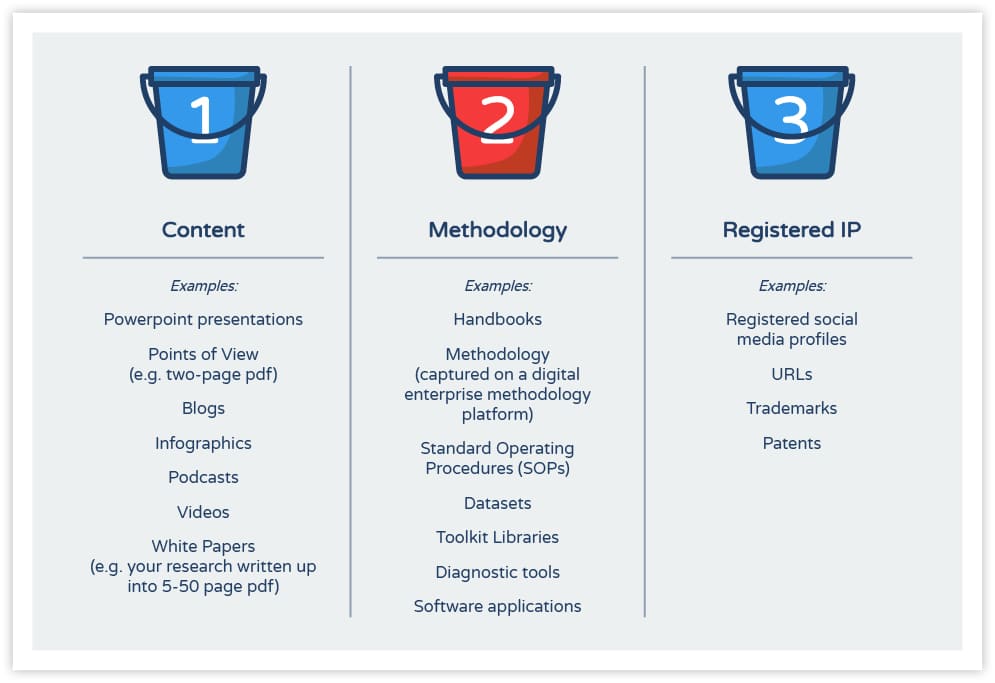
Figure: Three intellectual property buckets
As the graphic above illustrates, the topic of intellectual property is broad.
At the simplest level, you are starting to develop IP when you generate any unique content that reinforces your firm’s areas of expertise. The key word to emphasise here – per the title of this lever – is systematic. Such content takes on exponential value as it starts to build into a meaningful collection or body of work. This means developing a systematic, regular discipline as opposed to the occasional blog post.
As a side note here: there is a current meme to the effect that attention spans are reducing – and that all such content should now be bite-sized. I would throw a touch of caution to this observation (see this interesting article > Attention spans are getting shorter? Or, are they?).
A more accurate deduction is that prospect clients will seek to digest information in a range of ways from the simple infographic, to the 10 minute podcast through to the detailed, evidenced paper. You should look to cater for this breadth of reader/viewer type. It is certainly the case, however, that video and podcast can powerfully elevate content to a new level (mental note to self!).
The next intellectual property category concerns the development of your methodology.
This, typically, requires more work and is harder to do – by dint of the fact it requires methodological/structured thinking (not everyone is good at this) and, typically, collaborative authorship. The value gains, however, are invariably justified as this form of IP really talks to the benefits highlighted in my opening story – it is the type of investment that materially differentiates you from others.
Eighty percent of businesses get this point but are perpetually too busy working “in the business” to ever spend time in this strategic “on the business” activity. The 20% that do are the ones that build out of an unpredictable (often-mediocre) trading sine-wave to a far more predictable, growing revenue stream – as such IP makes the excellent repeatable and underpins expert-service differentiation and consistency.
As a side thought here – especially for the highly-utilised amongst you: a great way of breaking this impasse is to be alert to the opportunity of developing IP as a (legitimate!) component of a paid client engagement. We would often, with our client’s permission, develop an innovative methodology/toolbox/framework at their specific request that could, with some parallel effort, be easily adapted towards a repeatable, master version. Keep your eyes wide open for such opportunities.
Now, as readers of the Climbing Mount Audacity blog series know, I only rarely signpost back to the Method Grid solution but this is – clearly – a very relevant moment to do so!
Method Grid was born out of the recognition that whilst developed methodology is one of the most powerful forms of intellectual property you can ever develop – it is also one of the hardest. So whilst Method Grid will not develop your methodological IP for you (we can trigger ideas – but the IP ultimately has to be yours!), if you do decide to invest time and intellectual-energy in this critical area, this solution eases the method-building process and optimises the end-user experience.
Our solution sits in a fairly new category of software – enterprise methodology platform (EMP). Whilst I am emphasising that a digital solution is never the full answer to this challenge – it clearly is a foundational component – so it is important to take the time in resolving where and how you build such IP.
Developing your own expensive, bespoke platform (as I did “back in the day”) is rarely the right answer – as always likely to be a pale imitation of specialist platforms, detracts from your core competence, is expensive to upgrade and maintain etc. I would encourage you, rather, to explore existing solutions and the following rubric might help with such an evaluation:
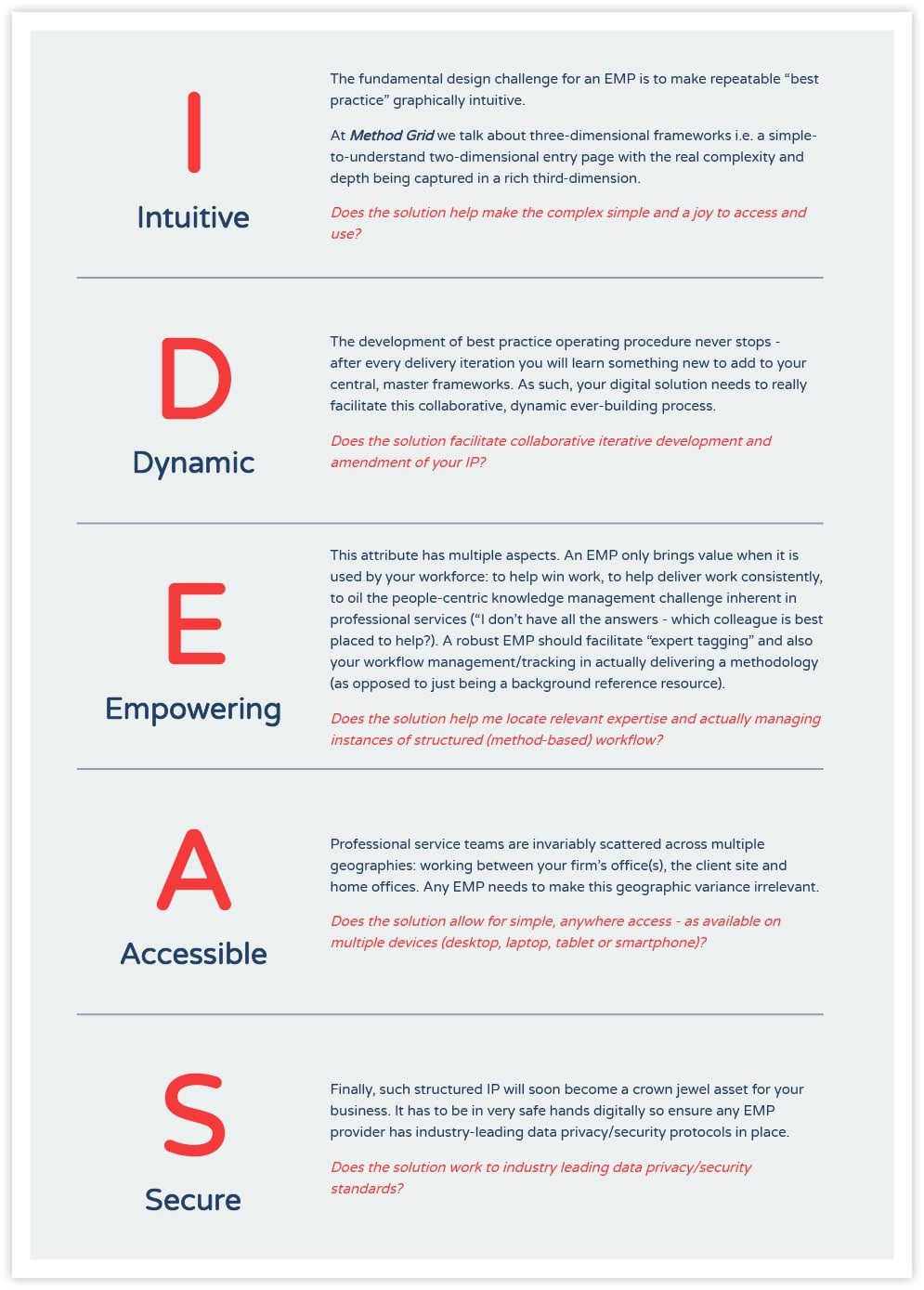
Figure: A framework for evaluating an Enterprise Methodology Platform
The best evaluation of whether a solution such as Method Grid works for your circumstances is to give it a go; the proof of value is always in the practical effect – not the theoretical conjecture.
So, if of intrigue, I would recommend that you take out our free trial and bring in a small group of colleagues initially to collaboratively build out a simple first example – your core service methodology for example – and then deploy it to increasing circles of the wider team. You will soon get a sense of the value such a solution (and the IP it hosts!) can bring to your operation.
My final bucket of registered intellectual property talks to how you can defend such investment – to metaphorically “build the moat”.
Even aside from legal instruments (trademarks, patents etc) there is much you can do to systematically develop your IP in this regard.
Methodology can be such a dry concept and term for many. The challenge is to bring it to life – to humanise it.
Few will be captured by the “our staged methodology for the delivery of commercial due diligence engagements”. “MAVEN”, however, sat behind a professionally designed brand elevates this completely – even if you can’t legally protect the constituent components – you can trademark the branding and shift it’s resonance and value up another notch.

Figure: Bring your tools/methods to life – brand your IP
So, there you have it; hopefully some food for thought with respect to how your newly formed KM team (see Lever 01) can be the catalysts for the systematic development of your IP.
So, what’s next?
Next week, I will continue this sub-series on knowledge management by describing how knowledge sharing is enabled by curated digital repositories.
Hopefully, you’ll join us on this journey. It’s totally free, and you don’t have to be a Method Grid customer (though you’re more than welcome to sign up for a free trial here).
We’ll be releasing a new post each week. To get each post emailed to you as soon as it’s published, sign up for the Climbing Mount Audacity mailing list below.
Climbing Mount Audacity…
From Startup to Scaleup!
We're sharing everything we know about how to build an awesome professional service firm (and enjoy the journey en route!) PLUS travel updates, reflections on our stumbles and general musings on our Method Grid journey.
Signup below to get the latest articles
direct to your inbox.
See you next week. Have something you want to hear more about? Let me know in the comments below or via Twitter.




